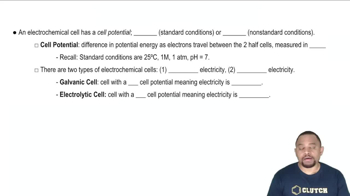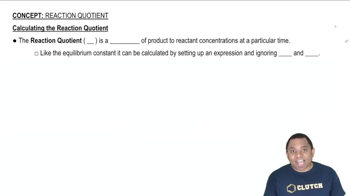A metal forms the fluoride MF3. Electrolysis of the molten fluo- ride by a current of 3.86 A for 16.2 minutes deposits 1.25 g of the metal. Calculate the molar mass of the metal.
Ch.20 - Electrochemistry
Chapter 20, Problem 133
An MnO2(s)/Mn2+(aq) electrode in which the pH si 10.24 is prepared. Find the [Mn2+] necessary to lower the potential of the half-cell to 0.00 V (at 25°C)
 Verified step by step guidance
Verified step by step guidance1
Identify the half-reaction for the MnO2(s)/Mn2+(aq) electrode: \( \text{MnO}_2(s) + 4\text{H}^+(aq) + 2\text{e}^- \rightarrow \text{Mn}^{2+}(aq) + 2\text{H}_2\text{O}(l) \).
Use the Nernst equation to relate the cell potential to the concentrations and pH: \( E = E^0 - \frac{RT}{nF} \ln Q \), where \( Q \) is the reaction quotient.
Determine the standard reduction potential \( E^0 \) for the half-reaction from a standard reduction potential table.
Calculate the reaction quotient \( Q \) using \( Q = \frac{[\text{Mn}^{2+}]}{[\text{H}^+]^4} \). Given \( \text{pH} = 10.24 \), find \( [\text{H}^+] = 10^{-10.24} \).
Set \( E = 0.00 \) V and solve the Nernst equation for \( [\text{Mn}^{2+}] \) to find the concentration necessary to achieve the desired potential.

Verified video answer for a similar problem:
This video solution was recommended by our tutors as helpful for the problem above.
Video duration:
6mWas this helpful?
Key Concepts
Here are the essential concepts you must grasp in order to answer the question correctly.
Nernst Equation
The Nernst Equation relates the reduction potential of an electrochemical cell to the concentrations of the reactants and products. It is expressed as E = E° - (RT/nF) ln(Q), where E is the cell potential, E° is the standard potential, R is the gas constant, T is the temperature in Kelvin, n is the number of moles of electrons transferred, F is Faraday's constant, and Q is the reaction quotient. This equation is essential for calculating the potential of the half-cell under non-standard conditions.
Recommended video:
Guided course

The Nernst Equation
pH and its Effect on Electrochemical Reactions
pH is a measure of the hydrogen ion concentration in a solution, which can significantly influence the behavior of electrochemical reactions. In this case, a pH of 10.24 indicates a basic environment, affecting the solubility and speciation of manganese ions. Understanding how pH alters the equilibrium of the MnO2/Mn2+ system is crucial for determining the necessary concentration of Mn2+ to achieve the desired potential.
Recommended video:
Guided course

Cell Potential and Spontaneity
Equilibrium and Reaction Quotient (Q)
The reaction quotient (Q) is a measure of the relative concentrations of products and reactants at any point in a reaction. For the MnO2/Mn2+ half-cell, Q can be expressed as [Mn2+]/[MnO2]. At equilibrium, Q equals the equilibrium constant (K), and changes in concentration will shift the equilibrium position according to Le Chatelier's principle. This concept is vital for understanding how to manipulate [Mn2+] to achieve a specific cell potential.
Recommended video:
Guided course

Reaction Quotient Q
Related Practice
Textbook Question
Textbook Question
A sample of impure tin of mass 0.535 g is dissolved in strong acid to give a solution of Sn2+. The solution is then titrated with a 0.0448 M solution of NO3–, which is reduced to NO(g). The equivalence point is reached upon the addition of 0.0344 L of the NO3– solution. Find the percent by mass of tin in the original sample, assuming that it contains no other reducing agents.
Textbook Question
A current of 11.3 A is applied to 1.25 L of a solution of 0.552 M HBr converting some of the H+ to H2(g), which bubles out of solution. What is the pH of the solution after 73 minutes?
Textbook Question
To what pH should you adjust a standard hydrogen electrode to get an electrode potential of -0.122 V? (Assume that the partial pressure of hydrogen gas remains at 1 atm.)
1
views
